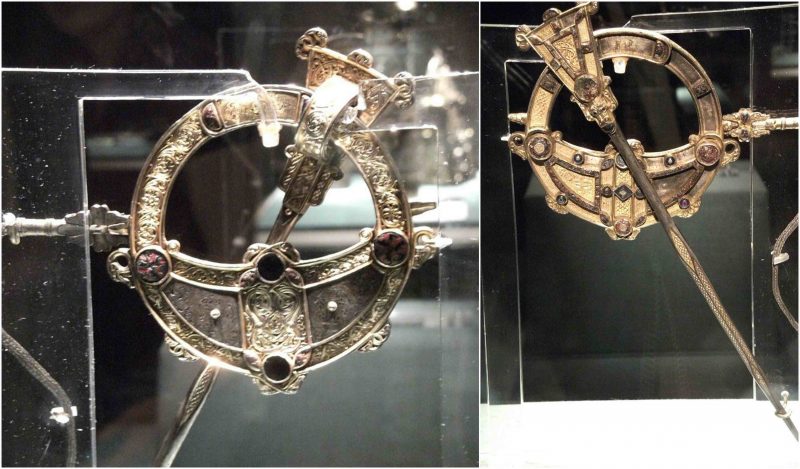The Tara Brooch was found in 1850 and rapidly recognized as one of the most important works of early Christian Irish Insular art; it is now displayed in the National Museum of Ireland in Dublin.
Although the brooch is named after the Hill of Tara, traditionally seen as the seat of the High Kings of Ireland, the Tara Brooch has no connection to either the Hill of Tara or the High Kings of Ireland.
The brooch was supposedly found in August 1850 on the beach at Bettystown, near Laytown, County Meath, some 50 km (30 mi) north of Dublin. The finder, a peasant woman (or her two sons), claimed to have found it in a box buried in the sand, though many think it was in fact found inland and she claimed it was found at the beach to avoid a legal claim by the landowner.
It was sold to a dealer and then to the Dublin jeweler George Waterhouse who was already producing Celtic Revival jewelry and who renamed it the “Tara Brooch” to make it more appealing.

Created in about 700 AD, the 7 inches (18 cm) long pseudo-penannular brooch is composed primarily of silver-gilt and is embellished with intricate abstract decoration including interlace on both front and back.
It was made in many pieces, with much of the decoration on small “trays” or panels which were then fixed into place. When it was found only one panel of decoration was missing, but several more have now disappeared, apparently before 1872, when it entered the collection of the Royal Irish Academy, who later transferred their collection of antiquities to the new National Museum.
It is probably the most spectacular, and one of the best preserved, of several dozen high-status brooches found in Britain or Ireland, but mostly in Ireland. Although similar in style, each has a completely individual design in detail. Precious metals are used, but only semiprecious stones.

The design, the techniques of workmanship (including filigree and inlaying) and the gold, silver, copper, amber and glass are all of high quality, and exemplify the advanced state of goldsmithing in Ireland in the seventh century. The brooch has a pseudo-penannular form. Like most brooches of the period, it contains neither Christian nor pagan religious motifs, and was made for a wealthy patron, almost certainly male, who wanted a personal expression of status.

Celtic Revival jewellery had become very fashionable over the previous decade, and the discovery of the brooch could hardly have been better timed from this point of view.
The brooch was immediately recognised as the culminating masterpiece (though early in date) of the Irish development of large and superbly worked ornate brooches, a status it has retained ever since.
Waterhouse used it as the centre of displays of his replicas and imitations of Celtic brooches in his Dublin shop, also exhibiting it at The Great Exhibition in London in 1851 and the Paris Exposition Universelle, as well as the Dublin exhibition visited by the Queen in 1853 (Victoria had already seen it; it had been specially sent to Windsor Castle for her inspection).
Waterhouse had invented the brooch’s name, choosing to link it to the site associated with the High Kings of Ireland, “fully aware that this would feed the Irish middle-class fantasy of being descended from them”. By the time the brooch passed to what is now the National Museum of Ireland in the 1870s, “Tara brooch” had become a generic term for Celtic Revival brooches, some of which were now being made by Indian workshops for export to Europe
